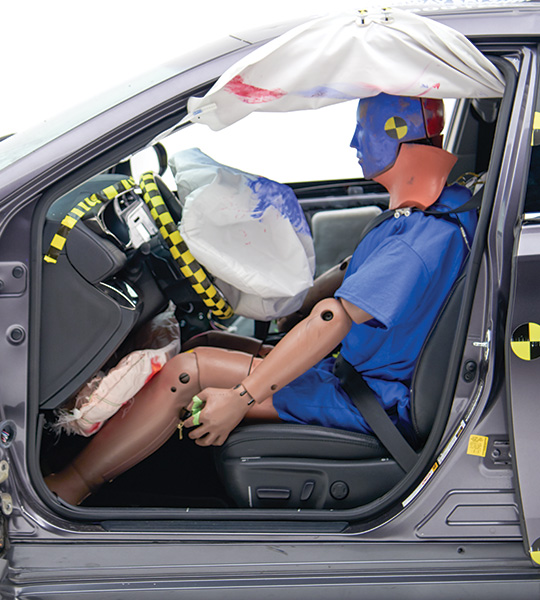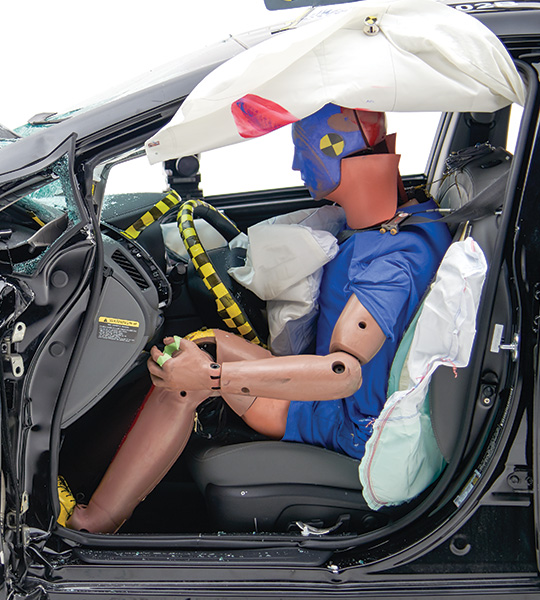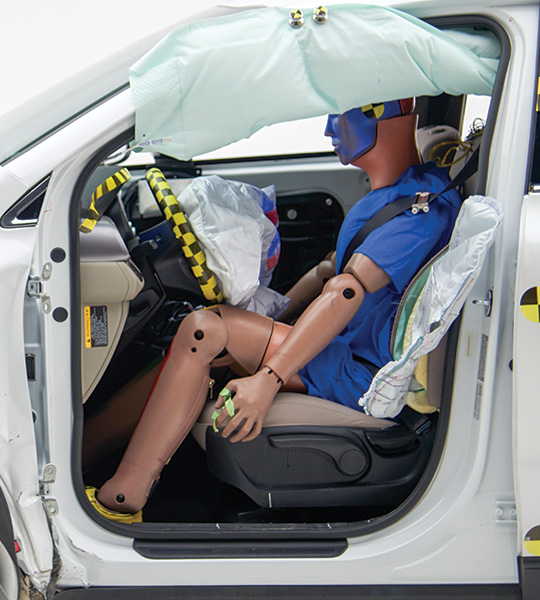IIHS used car lists help families choose safer, larger vehicles for teens
November 1, 2018
When it's time for a new driver's first set of wheels, many young people and their parents opt for something cute and inexpensive — in other words, small. In terms of safety, that's a mistake.
IIHS recently conducted a pair of front-to-front crash tests demonstrating what happens to small cars and minicars — even new ones with stellar safety ratings — when they collide with larger used vehicles from the same manufacturer. The results show the importance of size and weight when it comes to occupant protection.
The tests reinforce a message IIHS has been sending since it began publishing an annual list of recommended used vehicles for teens in 2014: An older, larger used vehicle is often a safer choice than a newer small vehicle that costs the same. This year's list of recommended vehicles for teens includes 53 Best Choices, which start under $20,000, and 62 Good Choices, which start under $10,000. All the models on both lists are midsize cars or larger.
"We know safety is just one of the factors people consider when choosing a vehicle, but we hope parents will give it extra consideration when purchasing a vehicle for a teenager," says Jessica Cicchino, IIHS vice president for research. "Teen drivers are at greater risk, due to immaturity and inexperience behind the wheel."
In its regular vehicle ratings program, IIHS evaluates passenger vehicles of all sizes, and even minicars are eligible for the Top Safety Pick and Top Safety Pick+ awards. That's a nod to the reality of the marketplace: Some consumers want small vehicles, and including them in the testing program encourages manufacturers to make those vehicles as safe as possible.
But the vehicles IIHS rates can't be compared across size and weight classes because the severity of the front and rear tests is determined in part by the vehicle's own weight. Consumers who opt for smaller vehicles are choosing a lower level of protection even if they purchase a Top Safety Pick winner.
Kia Sorento vs. Kia Forte and Toyota Avalon vs. Toyota Yaris iA
In the first of the two demonstration tests, a used 2016 Kia Sorento, a midsize SUV, and a 2018 Kia Forte, a small car, collided with each other. In the second test, a used 2015 Toyota Avalon, a large car, was paired with a 2018 Toyota Yaris iA, a minicar. Both the Sorento and the Avalon are among the IIHS Best Choices for teens. The Forte and the Yaris iA have good ratings in the five IIHS tests relevant to driver protection, and the Forte is a 2018 Top Safety Pick+ winner.
In each test, the vehicles traveled toward each other at 40 mph, with 50 percent of the smaller vehicle's width overlapping the larger vehicle.
Forces on the driver dummies in the smaller vehicles were much greater than those in the larger vehicles. Measurements indicated a high likelihood of head injuries for the driver of both the Yaris iA and the Forte in a real-world crash of the same severity. Right leg injuries would be likely in the Forte and possible in the Yaris iA. Neck and chest injuries would also be possible for drivers of both vehicles, and left leg injuries would be possible in the Forte.
In contrast, the Avalon and Sorento had mostly good injury measures, aside from a possible right leg injury in both.
The structures of the Forte, which weighs 928 pounds less than the Sorento, and the Yaris iA, which weighs 1,033 pounds less than the Avalon, didn't hold up as well against the larger vehicles as in the car-to-barrier tests on which IIHS ratings are based.
In the crash with the Sorento, the Forte had an acceptable structural rating, with maximum intrusion of 8 inches at the left toepan. In the crash with the Avalon, the Yaris iA also had an acceptable structural rating, with maximum intrusion of 10 inches at the center toepan. In contrast, the Forte and the Yaris iA earn good structural ratings in the moderate overlap and the driver-side small overlap front crash tests.
The Avalon and the Sorento had good structural performance in the paired crashes.
"Bigger vehicles provide greater protection," Cicchino says. "If you're riding in one of the smallest vehicles on the road, you'll be at a disadvantage in a crash with almost any other vehicle around you."




115 vehicles to choose from
IIHS compiles its list of recommended used vehicles for teens to help families choose vehicles with good safety credentials and reasonable price tags. Vehicles must meet specific safety criteria without exceeding the price limits. For the first time, IIHS is also factoring in data on insurance claim rates under first-party injury coverages. Prices for the used vehicles are provided by Kelley Blue Book, based on estimates for a private-party purchase near the Institute's Arlington, Va., office.
In addition to skipping minicars and small cars, the lists avoid excessive horsepower. Young drivers may be tempted to test the limits of a powerful engine. IIHS research has found that high-horsepower vehicles are more likely to exceed the speed limit. Analysis by HLDI, meanwhile, has found that high horsepower is strongly associated with higher insurance losses.
Vehicles that only come with powerful engines have been left off the lists, but some recommended models have high-horsepower versions. Parents are advised to stick with the base engines.
All recommended vehicles come with standard electronic stability control. This technology, which has been required on all new vehicles since the 2012 model year, cuts single-vehicle fatal crash risk in half by helping drivers maintain control on curves and slippery roads.
The models on this year's Good Choices list earn good ratings in the Institute's moderate overlap front, side, head restraint and roof strength tests. This is the first year that roof strength has been factored in for the under-$10,000 Good Choices list.
Vehicles on the Best Choices list (under $20,000) must meet the same criteria and also have a good or acceptable rating in the driver-side small overlap front test. This test, which was introduced in 2012, replicates what happens when the front, driver-side corner of a vehicle strikes another vehicle or an object such as a tree or utility pole.
Data on insurance losses were used to further narrow down the Best Choices. Models with substantially higher than average claim rates under medical payment or personal injury protection coverage were scratched from the list. Both coverage types pay for injuries to occupants of the insured vehicle. Which of the two coverages is sold in a given state depends on the type of insurance system the state has. HLDI publishes insurance loss data by make and model every year.
"The data that HLDI collects provide another perspective on how vehicles keep their occupants safe in the real world," Cicchino says.
Although many options are close to the $20,000 limit, there are a range of prices. The least expensive Best Choice is the 2005 Volvo XC90, which is estimated at $3,700.
If rated by the National Highway Traffic Safety Administration (NHTSA), vehicles on either list must earn 4 or 5 stars overall or 4 or 5 stars in the front and side tests under NHTSA's old rating scheme, which was used through the 2010 model year.
"Our list of recommended used vehicles shows you don't have to spend a fortune to keep your new driver safe," Cicchino says. "You just have to be willing to spend a little time looking for a good deal on the right used vehicle."